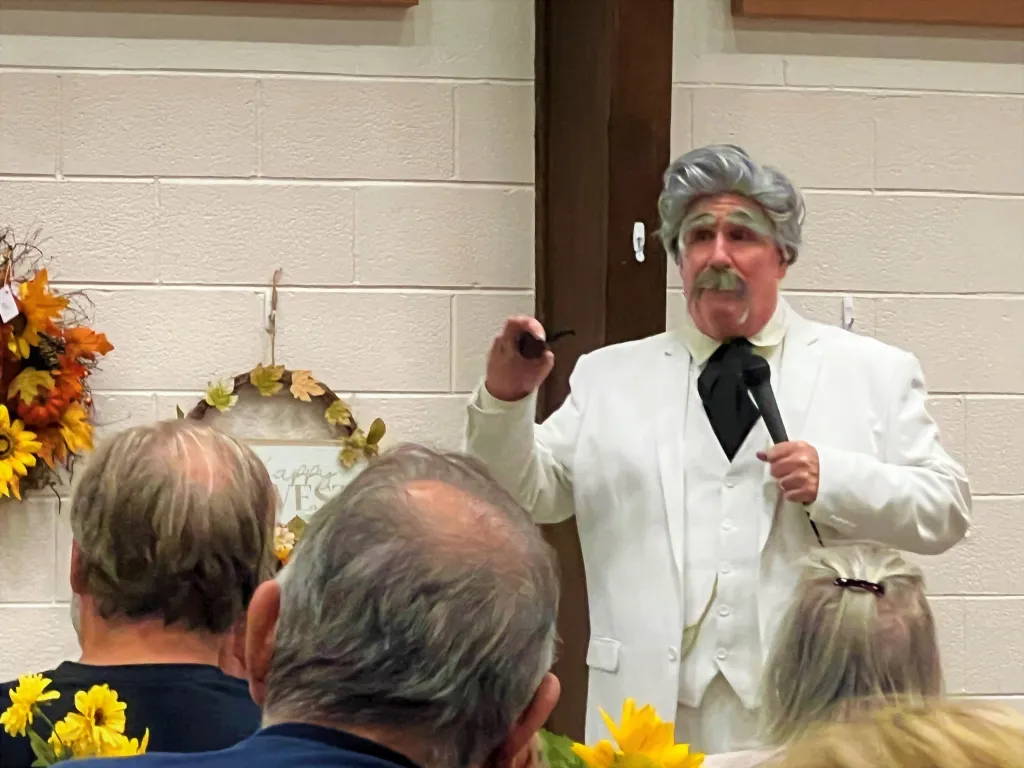
Donna Abercrombie of Munster invited me to attend a Sept. 9 luncheon in the gathering space at Southside Christian Church in Munster with the lure of her “special guest speaker being Mark Twain.”
Abercrombie, known to many for her more than two-decade career as a first-grade teacher at Kenwood Elementary School in Hammond, realized, of course, when booking this literature luminary that this couldn’t be the real man raised in Hannibal, Missouri, who penned such literary works as “Tom Sawyer” and “Huckleberry Finn.”
Abercrombie’s guest speaker was only a close facsimile of bushy-eyebrowed Twain, who died at age 74 in 1910. Featured tribute artist and lecturer Terry Lynch portrayed Twain in his 50-minute presentation titled” Between Two Comets: The Life of Mark Twain.”
“Twain was born Nov. 30, 1835, so he lived his life between the Halley’s Comets of 1835 and 1910,” Abercrombie said.
“And during his lifespan, he wrote some of the most beloved and controversial literature of the 19th century. Speaker Lynch, as Twain, tells audiences about his life, his writings and constant struggle to be accepted by society.”
Lynch’s last presentation to Abercrombie’s luncheon group a year ago had him in the guise of Saint Nicholas for a holiday event.
Born as Samuel Clemens, the author known by the pen name “Mark Twain” got his start surrounded by words, as did/do so many writers, working at a newspaper. In the case of Twain, he began as a typesetter and worked in St. Louis, Cincinnati, Philadelphia and New York City. But long before his dream of publishing books, Lynch says researchers and historians all agree that boyhood Twain originally aspired to be the captain-pilot of a steamboat, which promised both adventure and a big salary during that era.
Instead of river travels, Twain headed west, where he was inspired to write some of his earliest works published in newspapers on both the east and west coasts, like the Sacramento Union and the New York Tribune.
Lynch said it was once Twain married in 1870 to his longtime girlfriend Olivia Langdon, who was from a wealthy family on the East Coast, that the couple settled in Hartford, Connecticut, with a large estate and summer farm in nearby Elmira called Quarry Farm. All of his classic novels were written and published during his 17 years in Hartford and more than 20 summers at Quarry Farm, including “The Adventures of Tom Sawyer” (1876), “The Prince and the Pauper” (1881), “Life on the Mississippi” (1883), “Adventures of Huckleberry Finn” (1884) and “A Connecticut Yankee in King Arthur’s Court” (1889).
What surprised me most about Lynch’s presentation about Twain is the financial drain the writer experienced in later years despite his sizeable earnings and success. It was his poorly conceived investments in inventions that depleted much of his wealth, such as investing heavily in a typesetting machine just as the launch of Linotype technology would make typesetters obsolete. Establishing his own publishing house as Charles L. Webster and Company was also a ruined venture despite modest success selling the memoirs of Ulysses S. Grant, but later failure with lack of sales for the published biography of Pope Leo XIII.
“What Twain should have invested in, when he had an early opportunity, was to buy stock in Bell Telephone and Telegraph, which he chose not to do,” Lynch said.
“And this seems even more odd, because he was one of the few people in his town to have his own private telephone line in his house, so he knew it was new technology that would be in demand.”
Fortunately, it was his friend Henry Huttleston Rogers, one of the principal owners of Standard Oil, and a pal he’d known since 1893, who helped Twain save his literature holdings.
Rogers had Twain file for bankruptcy protection in April 1894 and transfer to his wife the copyrights on all his written works to prevent creditors from gaining the publishing rights to his library.
He was preceded in death by his wife in 1904, and two of his four children, which led to Twain suffering bouts of depression in his final years, though still in demand as a speaker and guest lecturer. He died of a heart attack at his Manhattan home in April 1910.
Abercrombie’s Sept. 9 Twain luncheon included a delicious vinegar-based salad with contrasting confetti created by a blend of pimentos, shoe peg corn, spring green peas and French sliced green beans. This recipe, courtesy of Shirley McKnight of Munster, is just as colorful as the characters dreamed up by Twain so long ago.
Columnist Philip Potempa has published four cookbooks and is a radio host on WJOB 1230 AM. He can be reached at PhilPotempa@gmail.com or mail your questions: From the Farm, PO Box 68, San Pierre, Ind. 46374.
Shirley’s Chilled Vegetable Salad
Makes 10 servings
Dressing:
1/2 cup oil
1/2 cup vinegar
1 cup sugar
Salad:
1/2 cup diced green pepper
1/2 cup diced onion
1/2 cup diced celery
1 can (14 ounce) shoe peg white corn, drained
1 can (14 ounce) small spring peas, drained
2 cans (14 ounces each) French-style green beans
1 small jar (4 ounces) red diced pimentos
Directions:



